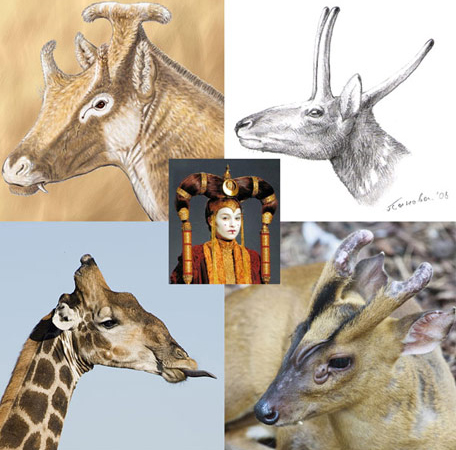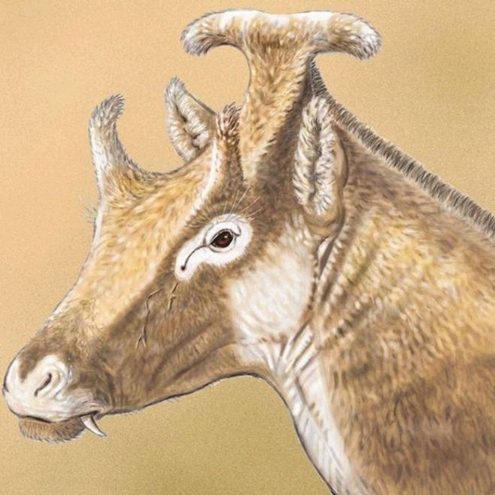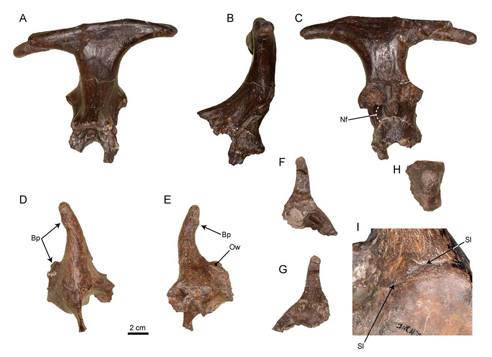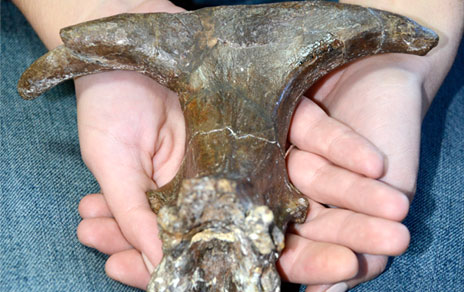Xenokeryx and Giraffes – Something to Ruminate On
Miocene Ruminant Related to Modern Giraffes
If we set aside those ubiquitous rodents for a moment, then the ruminants could rightly lay claim to being one of the most diverse, geographically widespread and successful of all the mammals. The first ruminants appeared during the Eocene Epoch and they certainly evolved into some weird and wonderful forms. Take the latest edition to the ruminant family Xenokeryx amidalae for example, this strange Miocene beast with three horns and fangs may have helped resolve the taxonomic affinities of giraffes and the enigmatic okapi within the Class Mammalia.
Xenokeryx amidalae
An Illustration of the Newly Described Xenokeryx amidalae
Picture credit: Departamento de Paleobiología, Museo Nacional de Ciencias Naturales-CSIC, Madrid, Spain
Ruminants include camels, deer, giraffes, goats, bovoids (cattle), sheep, antelopes, gazelles and a number of extinct families. They have a highly specialised digestive tract that allows them to extract nutrients from tough plant matter through the process of fermentation. Many evolved horns or antlers for use in fighting or display.
Palaeomerycids
Prior to this Spanish discovery one ancient group of ruminants the extinct palaeomerycids were thought to be closely related to the lineage of ruminants that led to the deer and antelope (dromomerycids).
However, analysis of the skull, teeth and horns of Xenokeryx amidalae suggests that the palaeomerycids are ancestral to the giraffids, represented today by the giraffe and the okapi.
A New Type of Palaeomerycid
The researchers from the National Museum of Natural Sciences (Madrid), in conjunction with Berlin based colleagues were able to examine the beautifully preserved fossilised remains of an entirely new type of palaeomerycid. These fossils were unearthed from a fossil site first explored in 1989 located near to the town of Loranca del Campo (Cuenca Province, Spain). A number of vertebrate fossils have been collected from this highly fossiliferous site (La Retama), representing the flora and fauna of an open grassland dotted with isolated lakes.
The rocks that have produced the fossils of X. amidalae have been dated to around 15.9 to 15.4 million years ago (Langhian faunal stage of the Miocene). Many of these early ruminants had fang-like teeth, some living deer species still have these teeth, they are used to settle disputes in the herd or in fights over mates.
Skull Material Including the Occipital Appendage (A-C) and he Cranial Ossicones (D-I)
Picture credit: Departamento de Paleobiología, Museo Nacional de Ciencias Naturales-CSIC, Madrid, Spain
Three Horns
Like all palaeomerycids, Xenokeryx possessed three horns. One was a strange “T-shaped” occipital process that formed a bizarre structure at the top of the skull. The other bony horns (referred to as ossicones) were positioned over the eyes. It is the strange occipital appendage that gave rise to the trivial name for this new palaeomerycid. The bony structure reminded the scientists of the bizarre headgear of Queen Padme Amidala from the planet Naboo in the fourth Star Wars movie “The Phantom Menace”. The genus name, Xenokeryx translates as “strange or alien horn”.
A New Analysis of the Ruminant Family Places Xenokeryx Basal to the Giraffids

Ancient ruminants (top) compared to extant ruminants (bottom) Queen Amidala (Star Wars) headdress inspires trivial name.
Picture credit: Israel M. Sánchez (Museo Nacional de Ciencias Naturales-CSIC, Madrid, Spain). The illustration of Pediomeryx is by Tori Morris.
The picture above shows the newly described Spanish palaeomerycid Xenokeryx (top left) compared to the North American extinct dromomerycid Pediomeryx (top right). An extant giraffe is picture below the Xenokeryx whilst the photograph underneath Pediomeryx is that of an extant muntjac (genus Muntiacus), a small deer.
Star Wars Inspiration
The study suggests that just as in the picture above the animals on the left are more closely related to each other than they are to the animals depicted on the right. The photograph of Queen Amidala provides a clue to the inspiration behind the species name.
Commenting on the study, lead author of the research, Israel M. Sánchez stated:
“Xenokeryx has not only allowed us to learn more about the group ruminants to which it belongs, the palaeomerycids, but also has provided critical data about the origin and early history of the evolutionary line of one of the strangest ruminants families today the giraffes. “
The X. amidalae fossils have provided scientists with a better understanding of palaeomerycid anatomy and permitted the phylogenetic tree to be redefined for the ruminant group, nesting the palaeomerycids away from deer and antelope and within a clade that includes giraffes, the okapi and their ancestral forms.
A Close Up of the Spectacular Bony Skull Ornamentation (Occipital Appendage)
Picture credit: Departamento de Paleobiología, Museo Nacional de Ciencias Naturales-CSIC, Madrid, Spain
This new fossil find and the subsequent research has certainly given palaeontologists something to chew over.




